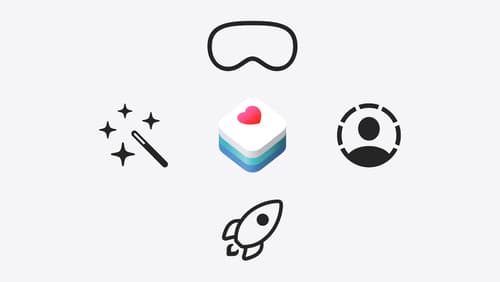How to create swift UI view
Asked on 2024-07-31
1 search
To create a SwiftUI view, you can follow the basic principles outlined in the SwiftUI essentials session. Here are the steps:
-
Start with a View: In SwiftUI, views are the basic building blocks of user interfaces. Every pixel you see on screen is defined by a view. Views in SwiftUI are declarative, compositional, and state-driven.
-
Declarative Syntax: You describe what view you want in your user interface, and SwiftUI produces the result. For example, you can create text, images using SF symbols, and controls like buttons. Here is a simple example of a horizontal stack containing a label, a spacer, and a text:
struct ContentView: View { var body: some View { HStack { Label("Label", systemImage: "star") Spacer() Text("End Text") } } } -
Compositional Views: SwiftUI allows you to compose views together. For example, you can use containers like
HStack,VStack, andZStackto arrange your views. Here is an example of a vertical stack:struct ContentView: View { var body: some View { VStack { Text("Hello, World!") Text("Welcome to SwiftUI") } } } -
State-Driven Views: SwiftUI views are driven by state. You can use state properties to manage the data that your views display. For example, you can create a button that updates a text view when tapped:
struct ContentView: View { @State private var count = 0 var body: some View { VStack { Text("Count: \(count)") Button("Increment") { count += 1 } } } } -
Custom Views: You can also create custom views by composing existing views and adding your own styles and behaviors. For example, creating a custom card view:
struct CardView: View { var title: String var subtitle: String var body: some View { VStack { Text(title) .font(.headline) Text(subtitle) .font(.subheadline) } .padding() .background(Color.gray.opacity(0.2)) .cornerRadius(10) } }
For more detailed information and examples, you can refer to the SwiftUI essentials session from WWDC 2024.

Migrate your TVML app to SwiftUI
SwiftUI helps you build great apps on all Apple platforms and is the preferred toolkit for bringing your content into the living room with tvOS 18. Learn how to use SwiftUI to create familiar layouts and controls from TVMLKit, and get tips and best practices.

SwiftUI essentials
Join us on a tour of SwiftUI, Apple’s declarative user interface framework. Learn essential concepts for building apps in SwiftUI, like views, state variables, and layout. Discover the breadth of APIs for building fully featured experiences and crafting unique custom components. Whether you’re brand new to SwiftUI or an experienced developer, you’ll learn how to take advantage of what SwiftUI has to offer when building great apps.

Get started with HealthKit in visionOS
Discover how to use HealthKit to create experiences that take full advantage of the spatial canvas. Learn the capabilities of HealthKit on the platform, find out how to bring an existing iPadOS app to visionOS, and explore the special considerations governing HealthKit during a Guest User session. You’ll also learn ways to use SwiftUI, Swift Charts, and Swift concurrency to craft innovative experiences with HealthKit.
